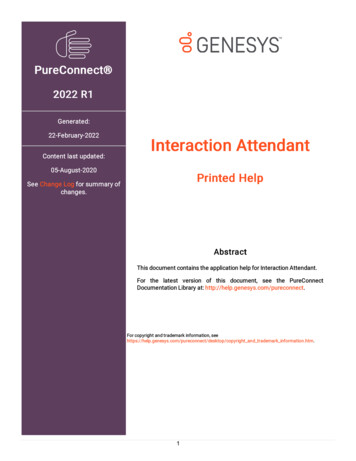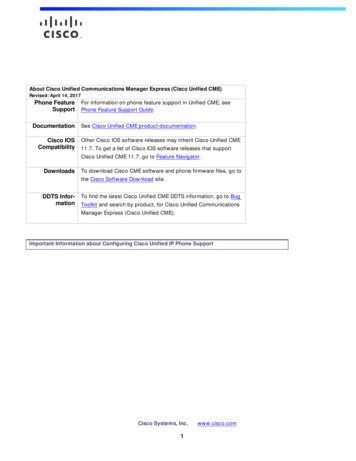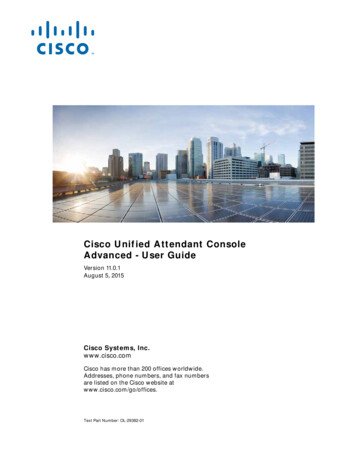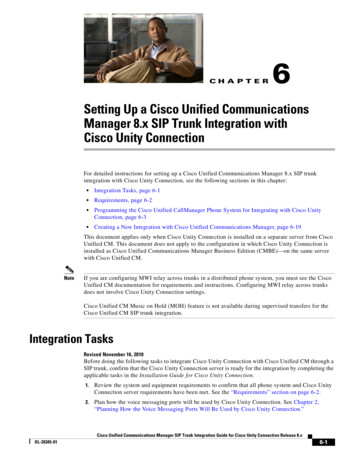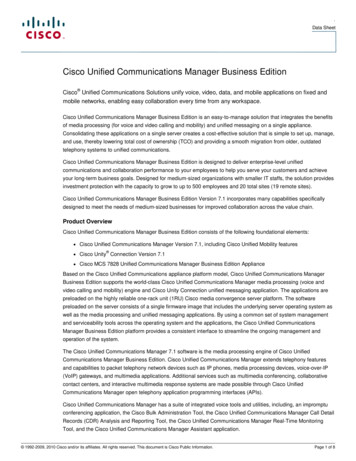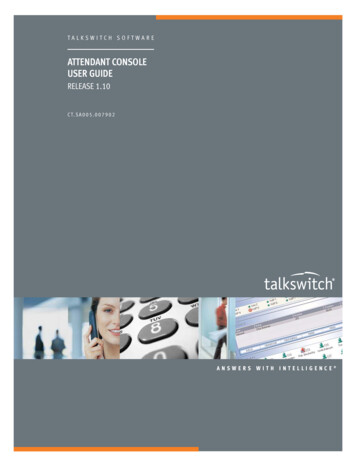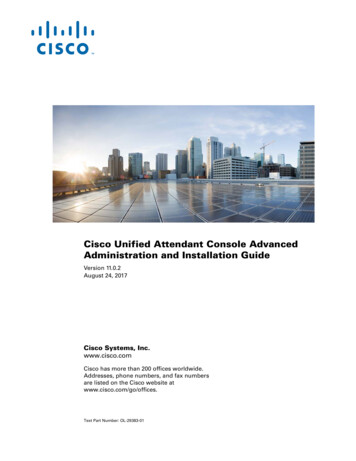
Transcription
Cisco Unified Attendant Console AdvancedAdministration and Installation GuideVersion 11.0.2August 24, 2017Cisco Systems, Inc.www.cisco.comCisco has more than 200 offices worldwide.Addresses, phone numbers, and fax numbersare listed on the Cisco website atwww.cisco.com/go/offices.Text Part Number: OL-29383-01
THE SPECIFICATIONS AND INFORMATION REGARDING THE PRODUCTS IN THIS MANUAL ARE SUBJECT TO CHANGE WITHOUT NOTICE. ALLSTATEMENTS, INFORMATION, AND RECOMMENDATIONS IN THIS MANUAL ARE BELIEVED TO BE ACCURATE BUT ARE PRESENTED WITHOUTWARRANTY OF ANY KIND, EXPRESS OR IMPLIED. USERS MUST TAKE FULL RESPONSIBILITY FOR THEIR APPLICATION OF ANY PRODUCTS.THE SOFTWARE LICENSE AND LIMITED WARRANTY FOR THE ACCOMPANYING PRODUCT ARE SET FORTH IN THE INFORMATION PACKET THATSHIPPED WITH THE PRODUCT AND ARE INCORPORATED HEREIN BY THIS REFERENCE. IF YOU ARE UNABLE TO LOCATE THE SOFTWARE LICENSEOR LIMITED WARRANTY, CONTACT YOUR CISCO REPRESENTATIVE FOR A COPY.The Cisco implementation of TCP header compression is an adaptation of a program developed by the University of California, Berkeley (UCB) as part of UCB’s publicdomain version of the UNIX operating system. All rights reserved. Copyright 1981, Regents of the University of California.NOTWITHSTANDING ANY OTHER WARRANTY HEREIN, ALL DOCUMENT FILES AND SOFTWARE OF THESE SUPPLIERS ARE PROVIDED “AS IS” WITHALL FAULTS. CISCO AND THE ABOVE-NAMED SUPPLIERS DISCLAIM ALL WARRANTIES, EXPRESSED OR IMPLIED, INCLUDING, WITHOUTLIMITATION, THOSE OF MERCHANTABILITY, FITNESS FOR A PARTICULAR PURPOSE AND NONINFRINGEMENT OR ARISING FROM A COURSE OFDEALING, USAGE, OR TRADE PRACTICE.IN NO EVENT SHALL CISCO OR ITS SUPPLIERS BE LIABLE FOR ANY INDIRECT, SPECIAL, CONSEQUENTIAL, OR INCIDENTAL DAMAGES, INCLUDING,WITHOUT LIMITATION, LOST PROFITS OR LOSS OR DAMAGE TO DATA ARISING OUT OF THE USE OR INABILITY TO USE THIS MANUAL, EVEN IF CISCOOR ITS SUPPLIERS HAVE BEEN ADVISED OF THE POSSIBILITY OF SUCH DAMAGES.CCDE, CCENT, CCSI, Cisco Eos, Cisco HealthPresence, Cisco Ironport, the Cisco logo, Cisco Lumin, Cisco Nexus, Cisco Nurse Connect, Cisco Stackpower,Cisco StadiumVision, Cisco TelePresence, Cisco Unified Computing System, Cisco WebEx, DCE, Flip Channels, Flip for Good, Flip Mino, Flip Video, Flip Video (Design),Flipshare (Design), Flip Ultra, and Welcome to the Human Network are trademarks; Changing the Way We Work, Live, Play, and Learn, Cisco Store, and Flip Gift Card areservice marks; and Access Registrar, Aironet, AsyncOS, Bringing the Meeting To You, Catalyst, CCDA, CCDP, CCIE, CCIP, CCNA, CCNP, CCSP, CCVP, Cisco, theCisco Certified Internetwork Expert logo, Cisco IOS, Cisco Press, Cisco Systems, Cisco Systems Capital, the Cisco Systems logo, Cisco Unity, Collaboration WithoutLimitation, EtherFast, EtherSwitch, Event Center, Fast Step, Follow Me Browsing, FormShare, GigaDrive, HomeLink, Internet Quotient, IOS, iPhone, iQuick Study,IronPort, the IronPort logo, LightStream, Linksys, MediaTone, MeetingPlace, MeetingPlace Chime Sound, MGX, Networkers, Networking Academy, Network Registrar,PCNow, PIX, PowerPanels, ProConnect, ScriptShare, SenderBase, SMARTnet, Spectrum Expert, StackWise, The Fastest Way to Increase Your Internet Quotient, TransPath,WebEx, and the WebEx logo are registered trademarks of Cisco Systems, Inc. and/or its affiliates in the United States and certain other countries.All other trademarks mentioned in this document or website are the property of their respective owners. The use of the word partner does not imply a partnership relationshipbetween Cisco and any other company. (0907R)Any Internet Protocol (IP) addresses used in this document are not intended to be actual addresses. Any examples, command display output, and figures included in thedocument are shown for illustrative purposes only. Any use of actual IP addresses in illustrative content is unintentional and coincidental.Cisco Unified Attendant Console Advanced Administration and Installation Guide 2017 Cisco Systems, Inc. All rights reserved.
CONTENTSPrefaceCHAPTER1ixProduct Overview1-1Features 1-1New Features in Version 11.0.2Core Languages 1-2Server Resilience 1-2Resilience Provided 1-41-2Cisco Unified Attendant Console Advanced Ports1-5Integrating Cisco Unified Attendant Console Advanced with Cisco Unified CommunicationsManager 1-7AXL Connectivity 1-7AXL Usage During Installation 1-7AXL Usage After Installation 1-8Non-resilient Installation Scenarios 1-8Resilient Installation Scenarios 1-8AXL API 1-9Cisco Unified Communications Manager System Devices 1-10Centralized Installations and Transcoding 1-10TAPI Resilience 1-11Music on Hold 1-11Cisco Unified Presence Server Integration 1-11CHAPTER2Deployment ChecklistCHAPTER3Hardware and Software Requirements2-13-1Server Requirements 3-1Physical Server Hardware Requirements 3-1Physical Server Software Requirements 3-2VMware Server Requirements 3-5VMware Guest Machine Requirements 3-5VMware Software Requirements 3-6Additional Server Considerations 3-6SQL Server Express Limitations 3-6SQL and Cisco Unified Attendant Console Advanced Server Resilience3-7Cisco Unified Attendant Console Administration and Installation GuideOL-29383-01iii
ContentsMicrosoft Windows, SQL, and Java Updates and Service PacksData Backup 3-7Server Redundancy 3-7Antivirus Software 3-7Network Requirements 3-9Citrix Support 3-9Jabber Support 3-10Cisco Unified Attendant Console Advanced Client RequirementsPC Hardware Requirements 3-10PC Software Requirements 3-10Windows Updates and Service Packs 3-11Operator Phone Requirements 3-11CHAPTER44-14-1Assigning Roles to an Access Control Group4-2Creating and Assigning an Application User4-2Configuring Access to Cisco Unified Presence Server53-10Preparing Cisco Unified Communications Manager and Cisco Unified PresenceCreating an Access Control GroupCHAPTER3-74-3Installing Cisco Unified Attendant Console Advanced Software5-1Preparing SQL 5-2Installing SQL Server 2008 5-2Installing SQL Server 2012 5-3Installing SQL Server 2014 5-5Licensing SQL Server 5-6Obtaining Cisco Unified Attendant Console Advanced Software 5-7Evaluating Cisco Unified Attendant Console Advanced Software 5-7Creating a Cisco Unified Attendant Console Advanced Downloads and Licensing Website UserAccount 5-7Downloading the Software 5-8Installing Cisco Unified Attendant Console Advanced Server 5-9Resilient Installation Prerequisites 5-9Cisco Unified Attendant Console Advanced Server Installation ProcedureDisabling Remote Access Connection Manager Service 5-13Disabling CUPS to Harden the System 5-135-10Installing Cisco Unified Attendant Console Advanced Client 5-13Installing JAWS Scripts for Visually Impaired Operation 5-15Cisco Unified Attendant Console Administration and Installation GuideivOL-29383-01
ContentsCHAPTER6Configuring and Licensing Cisco Unified Attendant Console Advanced ServerAdministrator Login6-16-1Home Page 6-2Menu Options 6-2Toolbar 6-3Data Entry Fields 6-4Accessibility for Users with Disabilities6-4Licensing Cisco Unified Attendant Console Advanced SoftwareLicensing Evaluation Software 6-5Licensing Purchased Software 6-6Relicensing Software 6-76-4Engineering Menu 6-7Administrator Management 6-7Server Management 6-8Database Management 6-8Database Purge 6-10Service Management 6-10Cisco Unified Attendant Server Status 6-12Cisco Unified Attendant LDAP Plug-in Status 6-12Cisco Unified Attendant CUPS Plug-in Status 6-13Cisco Unified Attendant BLF Plug-in Status 6-13CUCM Connectivity 6-13CUPS Connectivity 6-15Logging Management 6-16Cisco Unified Attendant Console Advanced Server LoggingCisco Unified Attendant LDAP Plug-in Logging 6-17Cisco Unified Attendant CUPS Plug-in Logging 6-17Cisco Unified Attendant BLF Plug-in Logging 6-17Log Collection 6-186-16System Configuration Menu 6-19Queue Device Groups 6-19Creating Queue Device Groups 6-20Deleting Queue Device Groups 6-20System Device Management 6-21Synchronize with CUCM 6-23Directory Source Management 6-27Mapping Cisco Unified Attendant Console Advanced Fields to an LDAP Directory SourceConnecting to a Directory Source 6-29Directory Synchronization 6-306-28Cisco Unified Attendant Console Administration and Installation GuideOL-29383-01v
ContentsDirectory Field Mapping 6-31Directory Rules 6-32Contact Management 6-33Adding Contacts 6-33Modifying Contact Information 6-34Deleting Contacts 6-34Directory BLF Rules 6-35Creating Directory BLF Rules 6-35Editing Directory BLF Rules 6-36Deleting Directory BLF Rules 6-36Applying BLF Directory Rules 6-36User Configuration Menu 6-37General Properties 6-37Queue Management 6-39Creating Queues 6-39Configuring Queues 6-40Operator Management 6-43Creating Operator Profiles 6-43Configuring Operator Profiles 6-43Configuring Out of Hours Routing 6-44Creating Out of Hours Routing Templates From Scratch 6-45Creating Out of Hours Routing Templates by Copying 6-46Deleting Out of Hours Routing Templates 6-47Editing Out of Hours Routing Templates 6-47Bulk Administration Menu 6-48Uploading New CSV Files 6-48Managing Uploaded CSV Files 6-49Inserting and Updating Contacts 6-49Inserting Contacts 6-49Updating Contacts 6-50Scheduling Contact Insertion and UpdatingExporting Contacts to CSV Files 6-516-50Cisco Unified Replication 6-52SQL Server Replication 6-54Configuring Server Replication 6-54Installing Replication 6-56Uninstalling Replication 6-58Re-initializing Replication 6-59Monitoring Replication 6-59Cisco Unified Attendant Console Administration and Installation GuideviOL-29383-01
ContentsValidating Replication 6-59Replication Report 6-60APPENDIXAUninstalling Cisco Unified Attendant Console Advanced ServerUninstalling Microsoft SQL ServerUninstalling the .NET FrameworkAPPENDIXBUninstalling Cisco TSPA-3Cisco Unified ReportingB-1ToolbarA-1A-2A-2B-2Setting Report Parameters B-2Date Range B-2Time Range B-2Queue Type B-3Attendant Operators B-3Incoming Calls by Date and Time System ReportOperator Calls by Time System ReportOperator Calls by Queue System ReportOperator Availability ReportB-3B-4B-5B-5Overflowed Calls By Date System ReportB-6APPENDIXCExample Cisco Unified Attendant Console Advanced ConfigurationAPPENDIXDUpgrading Cisco Unified Attendant Console AdvancedD-1Upgrading Cisco Unified Attendant Console Advanced ServerAPPENDIXEC-1D-3Backing-up and Restoring Cisco Unified Attendant Console AdvancedE-1Backing-up Databases E-1Manually Backing-up Databases E-2Automatically Backing-up Databases E-2Restoring Databases E-4Preparing the Server E-4Restoring the Databases E-5Reconnecting a Subscriber Server to a Restored Publisher ServerBacking-up and Restoring the CUPS ConfigurationRestoring a Subscriber ServerLicensing Your New ServerE-6E-6E-7E-8Cisco Unified Attendant Console Administration and Installation GuideOL-29383-01vii
ContentsAPPENDIXFUpdating the Cisco Unified Attendant Console Advanced Server Host NameUpdating the Server Registry with the New Host NameF-1F-1Changing SQL Server Host Name, Login and Password F-2Obtaining the Batch Files F-2Preparing the Batch Files For Standalone Installation F-3Before Running the Batch Files F-3Running the Batch Files F-4Running SqlCfgChange.bat F-4Running ServerChange.bat F-5After Changing the Servers F-5If the Conversion Fails F-6Updating the XML Configuration Files with the New Host NameUpdating the CTI Server Configuration File F-6Updating the CUP Server Configuration File F-6Updating the Database Configuration File F-6F-6INDEXCisco Unified Attendant Console Administration and Installation GuideviiiOL-29383-01
PrefaceThis document describes how to install and configure Cisco Unified Attendant Console Advanced – itsdatabases, connections to Cisco Unified Communications Manager, and its system and user settings –using the Cisco Unified Attendant Console Advanced Administration web application.Who Should Read this GuideThe document is intended for: Deployment Engineers, who are responsible for:– System design– Preparing Cisco Unified Communications Manager– Installing the Cisco Unified Attendant Console Advanced server and Cisco Unified AttendantConsole Advanced client– Configuring the Cisco Unified Attendant Console Advanced server System AdministratorsThis document assumes that you have knowledge of: Cisco Unified Communications Manager Windows operating systems TCP/IPHow this Guide is OrganizedThis guide contains the following sections:SectionContainsChapter 1, “Product Overview”An overview of Cisco Unified Attendant ConsoleAdvanced, including its compatibility with CiscoUnified Communications Manager.Chapter 2, “Deployment Checklist”The steps to take when installing Cisco UnifiedAttendant Console Advanced, cross-referenced tothe relevant procedures in this guide.Cisco Unified Attendant Console AdvancedOL-29383-01ix
SectionContainsChapter 3, “Hardware and SoftwareRequirements”The Cisco Unified Attendant Console Advancedserver and Cisco Unified Attendant ConsoleAdvanced client hardware and softwarerequirements.Chapter 4, “Preparing Cisco UnifiedCommunications Manager and Cisco UnifiedPresence”How to configure Cisco Unified CommunicationsManager so that Cisco Unified Attendant ConsoleAdvanced can work with it.Chapter 5, “Installing Cisco Unified AttendantConsole Advanced Software”How to download, install and license Cisco UnifiedAttendant Console Advanced software.Chapter 6, “Configuring and Licensing CiscoUnified Attendant Console Advanced Server”How to configure Cisco Unified Attendant ConsoleAdvanced using Cisco Unified Attendant ConsoleAdvanced Administration.Appendix A, “Uninstalling Cisco UnifiedAttendant Console Advanced Server”How to uninstall Cisco Unified Attendant ConsoleAdvanced server.Appendix B, “Cisco Unified Reporting”How to create Cisco Unified Attendant ConsoleAdvanced Administration reports.Appendix C, “Example Cisco Unified Attendant An example of a resilient Cisco Unified AttendantConsole Advanced Configuration”Console Advanced configuration.Appendix D, “Upgrading Cisco UnifiedAttendant Console Advanced”How to upgrade a Cisco Unified Attendant ConsoleAdvanced system.Appendix E, “Backing-up and Restoring CiscoUnified Attendant Console Advanced”How to back up Cisco Unified Attendant ConsoleAdvanced server, and how to restore it followingfailures requiring a full system rebuild.Appendix F, “Updating the Cisco UnifiedAttendant Console Advanced Server HostName”How to update the Cisco Unified Attendant ConsoleAdvanced server host name during server migration,upgrade, or rebuild.Document ConventionsThis document uses the following conventions:ConventionIndicationbold fontCommands and keywords and user-entered text appear in bold font.italic fontDocument titles, new or emphasized terms, and arguments for which you supply valuesare in italic font.NoteMeans reader take note.TipMeans the following information will help you solve a problem.Cisco Unified Attendant Console Administration and Installation GuidexOL-29383-01
CautionMeans reader be careful. In this situation, you might do something that could result in equipmentdamage or loss of data.Obtaining Documentation and Submitting a Service RequestFor information on: Obtaining documentation Obtaining support Submitting service requests Providing documentation feedback Security guidelines Recommended aliases Gathering additional information A list of all new and revised Cisco technical documentationsee the monthly What’s New in Cisco Product Documentation w/whatsnew.htmlSubscribe to What’s New in Cisco Product Documentation as a Really Simple Syndication (RSS) feedand set content to be delivered directly to your desktop using a reader application. The RSS feeds are afree service and Cisco currently supports RSS Version 2.0.Cisco Unified Attendant Console Administration and Installation GuideOL-29383-01xi
Cisco Unified Attendant Console Administration and Installation GuidexiiOL-29383-01
CH A P T E R1Product OverviewCisco Unified Attendant Console Advanced is a Windows-based operator attendant console applicationfor use exclusively with Cisco Unified Communications Manager. For more information about whichversions of Cisco Unified Attendant Console Advanced and Cisco Unified Communications Managerwork together, see Integrating Cisco Unified Attendant Console Advanced with Cisco UnifiedCommunications Manager, page 1-7. Cisco Unified Attendant Console Advanced emulates the functionsof a manual telephone switchboard, and so enables attendant console operators to quickly acceptincoming calls and efficiently dispatch them to recipients within an organization.The Cisco Unified Attendant Console Advanced server monitors extensions within Cisco UnifiedCommunications Manager and routes the calls to the Cisco Unified Attendant Console Advanced clients.Calls from Cisco Unified Communications Manager enter Cisco Unified Attendant Console Advancedserver through Cisco Unified Communications Manager Computer Telephony Integration (CTI) RoutePoint devices, which can route calls, but cannot terminate them. Cisco Unified CommunicationsManager CTI Ports receive the calls and deliver them to the operators.You use Cisco Unified Attendant Console Advanced Administration to create the required systemdevices on the Cisco Unified Communications Manager, and to configure the system parameters on theCisco Unified Attendant Console Advanced server. Cisco Unified Attendant Console Advanced systemparameters, user directory and call record logs are all stored in SQL databases on the Cisco UnifiedAttendant Console Advanced server.FeaturesCisco Unified Attendant Console Advanced has the following basic features: Call queuing engine, with 100 Console queues supported Up to 50 concurrent operator client logins Busy Lamp Field (BLF) Blind and consultative transfers Optional server resilience Directory size supported—100K Optional use of these directory sources:– Cisco Unified Communications Manager End User Directory– Active Directory 2008 R1/R2– Active Directory 2012Cisco Unified Attendant Console Advanced - Administration and Installation GuideOL-29383-011-1
Chapter 1Product OverviewFeatures– iPlanet Netscape 5.0– iPlanet Netscape 5.1 Users can bulk import or export directory contacts from or to a CSV file using Cisco UnifiedAttendant Console Advanced Administration. Console GUI Features: Queue Statistics, Queue Colors, Auto Unavailable on idle, Drill downsearch, BLF Notification preference Microsoft Lync 2013 and Skype for Business support. Cisco Unified Communications Manager IM and PresenceFor a more detailed features list see the product data sheets cts data sheets list.html.New Features in Version 11.0.2Cisco Unified Attendant Console Advanced version 11.0.2 includes the following new features: Added support for ESXI 6.1. Support for CUCM 12.0(1) Support for IM&P 12.0(1) Defect resolutionCore LanguagesThe Cisco Unified Attendant Console Advanced Client, Help and User Guide are translated into thefollowing languages: Arabic Chinese (simplified) Chinese (traditional) Danish Dutch French German Italian Japanese Korean Portuguese Russian Spanish SwedishCisco Unified Attendant Console Advanced - Administration and Installation Guide1-2OL-29383-01
Chapter 1Product OverviewFeaturesServer ResilienceCisco Unified Attendant Console Advanced supports server resilience in an active/passive (hot standby)deployment, based on SQL Server replication and the synchronization of database objects acrosspublisher and subscriber servers. For more information on how replication is implemented in CiscoUnified Attendant Console Advanced, see Cisco Unified Replication, page 6-52.A resilient Cisco Unified Attendant Console Advanced installation runs on two servers: Publisher—responsible for normal activity. You configure the system by logging in to Cisco UnifiedAttendant Console Advanced Administration on the Publisher. By default, all operators using theAttendant Console client are logged onto the Publisher for configuration and call routing. ThePublisher includes the LDAP server. Subscriber—the passive, secondary (backup) server. The information from the publisher server isreplicated onto this server. The Subscriber runs the all the same services as the Publisher except thatit does not use an LDAP service to populate the directory, instead these are replicated entirely fromthe Publisher only. If the Publisher fails, the Subscriber takes over, communicating with theAttendant Console clients. You cannot change the configuration through the Subscriber server. Onthe Subscriber you can only set:– the arrival mode for each queue– logging levelsYou can also monitor replication and run reports.The following are installed on both server machines: BLF server. Responsible for all BLF information and call activity Cisco Unified Presence server. Responsible for presence information. For more information, seeCisco Unified Presence Server Integration, page 1-12.The two servers are linked using Apache Active MQ, an open-source message broker. When you updatesystem and user configuration on the Publisher, all the changes are sent to the Subscriber in real-time.If the Publisher fails the Attendant Console client applications automatically log out and offer their usersthe option to continue connected to the Subscriber.Apache Active MQ is also used for real-time synchronization of operator and queue availability. It alsoenables the Publisher and Subscriber to detect whether the other has failed.The Publisher and Subscriber servers can be part of a Microsoft Domain, so long as they can access eachother by hostname. Call Forwarding is used to transfer calls received on the Publisher Queue DDInumbers to the Subscriber Queue DDI numbers of the same queue.NoteIf the inter-server communication link is down, all online updates will fail. This is also true of thenon-resilient version of Cisco Unified Attendant Console Advanced.To check the status of the inter-server communication link:1.Log in to Cisco Unified Attendant Console Advanced Administration and choose Engineering Service Management.2.View the activity and status of the Cisco Unified Attendant Server.If the Inter Server Communication Status is Suspended, the ActiveMQ service may not be running.To check and restart the ActiveMQ service:1.In Control Panel, click Accessories, and then click Services.Cisco Unified Attendant Console Advanced - Administration and Installation GuideOL-29383-011-3
Chapter 1Product OverviewFeatures2.If the Status of the ActiveMQ service is blank (meaning that it is stopped), select the service andclick Start.3.Use Cisco Unified Attendant Console Advanced Administration to confirm that the Inter ServerCommunication Status is Normal.You can install Cisco Unified Attendant Console Advanced as a single-server (Publisher-only) system,with no resilience. If you install Cisco Unified Attendant Console Advanced as a non-resilient system,you can convert it to the resilient version by purchasing and installing a resilience license. When youinstall Cisco Unified Attendant Console Advanced as a Publisher-only system, if no SQL Server isdetected then SQL Server Express Edition is automatically installed on the server; you will also need toupgrade SQL Server to the Standard or Enterprise edition if you want to convert to a resilient system.For a resilient installation you must first install the Publisher server and then the Subscriber server (theSubscriber installation communicates with the Publisher). When you have installed a Publisher orSubscriber server you cannot convert it into the other server type. The Publisher requires at least SQLServer Standard to be installed, while the Subscriber can use SQL Server Express (which is installedautomatically when you install Cisco Unified Attendant Console Advanced, if no version of SQL Serveris already installed).Resilience ProvidedThe system is resilient to the following failures: Cisco Unified Call Manager node failure (partial failover). During normal operation, the primaryCisco Unified Attendant Console Advanced server on the Publisher server and the secondary CiscoUnified Attendant Console Advanced server on the Subscriber server connect to different CTIManagers within the same Cisco Unified Communications Manager cluster. For more informationabout CTI Manager, see AXL Usage During Installation, page 1-8. If the Cisco UnifiedCommunications Manager node used by the primary Cisco Unified Attendant Console Advancedserver fails, another Cisco Unified Communications Manager takes over and the primary CiscoUnified Attendant Console Advanced server continues to run. Primary CTI Manager on Publisher fails (partial failover). BLF Server fails (partial failover). If you remove all Queue DDI or CT Gateway devices using Cisco Unified Attendant ConsoleAdvanced Administration (partial failover). For example if Queue DDIs are manually removed fromthe TSP User Profile, the server remains active but calls follow the call forward set on Cisco UnifiedCommunications Manager to the Subscriber. You can still update the system configuration using theCisco Unified Attendant Console Advanced Administration on the Publisher. TSP failure. Database failure. Cisco Unified Attendant Console Advanced server failure (or server shut down, or failure of thecommunication channel between the Publisher and Subscriber servers).During a partial failover some or all of the primary Cisco Unified Communications Manager systemdevices go out of service. However the primary Cisco Unified Attendant Console Advanced server onthe Publisher server continues running because the TAPI-based CT Link continues working.Cisco Unified Attendant Console Advanced - Administration and Installation Guide1-4OL-29383-01
Chapter 1Product OverviewCisco Unified Attendant Console Advanced PortsCisco Unified Attendant Console Advanced PortsCisco Unified Attendant Console Advanced applications use TCP/IP and UDP Ports to communicatewith each other. In large networks, which often involve a WAN, you may need to prioritize the followingports across the network switches:PortNumberPortType80Relationship *FunctionTCPPub/Sub Internal andOpr - Pub/SubUsed by the Cisco Unified Attendant Console AdvancedXML Status Management service, which is hosted on theInternet Information Services (IIS) that runs on the CiscoUnified Attendant Console Advanced server. This servicelistens for HTTP requests from IP Phones and WebBrowsers, and sends requests to IP Phones.389TCPPub/Sub Internal orUsed to communicate with Microsoft Active Directory orPub/Sub - Directory iPlanet Netscape Directory when not using Secure SocketssourceLayer (SSL).443TCPCUCM - Pub/Sub636TCPPub/Sub Internal orUsed to communicate with Microsoft Active Directory orPub/Sub - Directory iPlanet Netscape Directory when using Secure SocketssourceLayer (SSL).Used by the AXL API to communicate with the CiscoUnified Communications Manager, with or without SecureSockets Layer (SSL).1433TCPand 1434Pub - Sub andOpr - Pub/SubUsed for SQL communication between servers and betweenservers and clients.1859TCPOpr - Pub/SubUsed by the Cisco Unified Attendant Console Advancedserver and the Cisco Unified Attendant Console Advancedclient to communicate across a LAN.1862TCPPub/Sub InternalUsed by the Cisco Unified Attendant Console AdvancedLDAP Server.1863TCPOpr - Pub/SubUsed for communication between the Cisco UnifiedAttendant Console Advanced CUP server and the CiscoUnified Attendant Console Advanced client.1864TCPOpr - Pub/SubUsed for communication between Cisco Unified AttendantConsole Advanced clients and the Cisco Unified AttendantConsole Advanced BLF plug-in that provides phone linestatus.2748TCPCUCM - Pub/SubUsed by the Cisco TSP to communicate between the CiscoUnified Attendant Console Advanced server and the CiscoUnified Communications Manager.5060UDP CUPS - Pub/SubUsed for communication between the Cisco UnifiedAttendant Console Advanced and the Cisco CUP servers.This is the default when not using Transport Layer Security.5061 or5062TCPUsed for communication between the Cisco UnifiedAttendant Console Advanced and the Cisco CUP servers.This is the default when using Transport Layer Security.CUPS - Pub/SubCisco Unified Attendant Console Advanced - Administration and Installation GuideOL-29383-011-5
Chapter 1Product OverviewCisco Unified Attendant Console Advanced PortsPortNumberPortTypeRelationship *Function11859TCPPub/Sub InternalUsed by the Cisco Unified Attendant Console Advancedservice to communicate with the Cisco Unified AttendantConsole Advanced server.61616TCPPub - Sub61618TCPPub - SubUsed to enable messages to be passed between Publisher andSubscriber servers in resilient installations.49152 to TCP65535Opr - Pub/SubCUCM - Pub/SubPub/Sub Internal1025 to5000TCPOpr - Pub/SubDynamic ports used to communicate between the CiscoUnified Attendant Console Server, Cisco UnifiedCommunications Manager, and the Operator PCs (runningWindows Server 2008 and later, or Windows Vista and later).If you are using Operator PCs running Windows XP, ports1025 to 5000 must also be open to accommodate the defaultdynamic port range of that operating system. For furtherinformation, visit http://support.microsoft.com/kb/832017.Dynamic ports used to communicate between the CiscoUnified Attendant Console Server and Operator PCs runningWindows XP. If your site does not have any Operator PCsrunning Windows XP, you can disregard this range. Forfurther information, visithttp://support.microsoft.com/kb/832017.* Relationship KeyCUCM Cisco Unified Communications ManagerCUPS Cisco Unified Presence serverOpr Attendant Console ClientPub Publisher ServerSub Subscriber ServerLDAP uses the following TCP/IP ports to communicate with Cisco Unified Communications Manager:TCP/IP Port Use389LDAP server does not use SSL and is not configured as the Global Catalog.636LDAP server uses SSL and is not configured as the Global Catalog.3268LDAP server does not use SSL a
Contents iv Cisco Unified Attendant Console Administration and Installation Guide OL-29383-01 Microsoft Windows, SQL, and Java Updates and Service Packs 3-7 Data Backup 3-7 Server Redundancy 3-7 Antivirus Software 3-7 Network Requirements 3-9 Citrix Support 3-9 Jabber Support 3-10 Cisco Unified Attendant Console Advanced Client Requirements 3-10 PC Hardware Requirements 3-10


